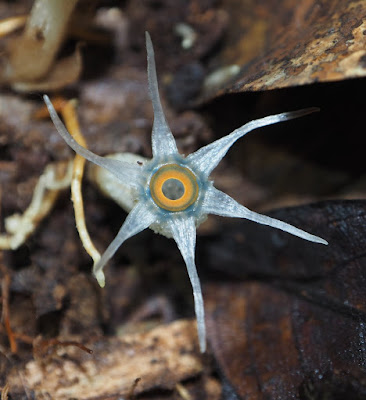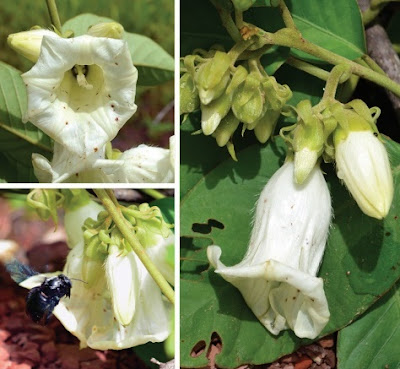[Most Recent Entries] [Calendar View]
Saturday, July 14th, 2018
| Time | Event | |||
| 7:20a | [Botany • 2018] Thismia kinabaluensis (Thismiaceae) • A New Species from Mt. Kinabalu, Sabah, Borneo
Abstract A new species of Thismia (Thismiaceae), Thismia kinabaluensis, is described from Mt. Kinabalu, Sabah, Borneo. Thismia kinabaluensis is clearly placed in section Thismia subsect. Odoardoa, in having its creeping vermiform roots and free and equal perianth lobes, and it is distinguished from the other members of this subsection by three anther appendages (one filiform appendage between two club shaped ones) and a pale-blue perianth tube with transverse bars inside. A key to the Malaysian Thismia is provided for easy identification of these mycoheterotrophic plants. Keywords: Burmanniaceae, mycoheterotrophy, taxonomy, tropical rain forest, Monocots Tatsuki Nishioka, Kenji Suetsugu, Rimi Repin and Kanehiro Kitayama. 2018. Thismia kinabaluensis (Thismiaceae), A New Species from Mt. Kinabalu, Sabah, Borneo. Phytotaxa. 360(2); 174–178. DOI: 10.11646/phytotaxa.360.2.10 | |||
| 5:00p | [Botany • 2018] Odontochilus putaoensis (Orchidaceae) • A New Species from Myanmar
Abstract Odontochilus putaoensis, a new species of Orchidaceae, is described and illustrated from Putao Township, Kachin State, Myanmar. Odontochilus putaoensis is close to O. duplex, but can be easily distinguished from the latter by having a light yellow lip, a bisaccate hypochile with a small, erect, blade-like and emarginate callus within each sac, a mesochile with a pair of dentate-pectinate flanges and a bilobed epichile with a pair of widely diverging lobes that are erect and concave. An identification key to the Southeast Asian species of Odontochilus and colour photographs of O. putaoensis are provided. A preliminary conservation assessment according to the IUCN Red List Categories and Criteria is given for the new species. Keywords: Cranichideae, Kachin State, key, new species, southeast Asia, terrestrial orchid Odontochilus putaoensis X.H. Jin, L.A. Ye & A.T. Mu, sp. nov. Diagnosis: Odontochilus putaoensis is similar to O. duplex, but can be easily distinguished from the latter by having a light yellow lip composed of a bisaccate hypochile with a small, erect, blade-like and emarginate callus within each sac, a mesochile with a pair of dentate-pectinate flanges and bilobed epichile with a pair of widely diverging lobes that are erect and concave. Type: MYANMAR. Kachin State: Putao Township, Hponkanrazi Wildlife Sanctuary, subtropical, evergreen, broad-leaved, montane forest, 2000 m a.s.l., 20 October 2014, Xiaohua Jin et al, PT-ET 959 (Holotype, PE!). .... Etymology: The new species is named after Putao, the northernmost town of Myanmar, near which it was discovered in a vast area of undisturbed mountain forest. Distribution and habitat: Odontochilus putaoensis grows in shaded and damp humus in humid, broad-leaved, evergreen forest, at an elevation of about 1500-2000 m. At present, O. putaoensis is only known from the type locality. Ye Lwin Aung, Aye Thin Mu and Xiaohua Jin. 2018. Odontochilus putaoensis (Cranichideae, Orchidaceae), A New Species from Myanmar. PhytoKeys. 103: 19-26. DOI: 10.3897/phytokeys.103.25913 | |||
| 5:05p | [Botany • 2018] Argyreia gyrobracteata • Species Delimitation of Some Argyreia (Convolvulaceae) Using Phenetic Analyses: Insights from Leaf Anatomical Data Reveal A New Species from northeastern Thailand
ABSTRACT Argyreia gyrobracteata Traiperm & Chitchak, sp. nov. Argyreia Lour. is one of the most taxonomically complex genera of the morning glory family (Convolvulaceae). The number of named species is now 135, and new species are regularly being described. There are several species complexes that are morphologically similar and difficult to tell apart. Therefore, the aim of this study is to explore the species identification criteria for Argyreia, especially new sources for taxonomically informative characters. Ten accessions representing three morphologically similar Argyreia operational taxonomic units (OTUs) were collected and their anatomical characters were investigated using the leaf peeling technique and paraffin sectioning method. Anatomical character states were analyzed using two phenetic analysis methods: clustering analysis (CA) and principal component analysis (PCA). Three distinct clusters were clearly separated in both PCA and CA at the internal similarity coefficient of 0.48 with a high R-value of 0.89757. Nineteen effectively distinguishable character states were derived from the high loadings of the first two components. In conclusion, two of the separated groups were matched with known species, and the third separated group is here delineated as a new species. Therefore, a new species, Argyreia gyrobracteata Traiperm & Chitchak, is described and illustrated together with ecological data and a preliminary conservation assessment. Keywords: cluster analysis, cryptic species, morphometrics, principal component analysis, species delimitation TYPE: Thailand. Ubon Ratchathani, Sirindhorn district, ..., in the edge of dipterocarp forest, August 2016, P. Rattanakrajang, N. Chitchak & P. Traiperm 110 (holotype BKF!; isotypes K!, QBG!) DIAGNOSIS: The new species is similar to A. mekongensis in having a white campanulate corolla, but differs from that species by the linear-oblong to narrowly lanceolate bract shape (versus lanceolate or oblong-lanceolate), the curly or twisted bract orientation (versus falcate), the larger sepals, and the multicellular, uniseriate, villous trichomes restricted to a small, dense, triangular patch on the adaxial side of the filaments, above the insertion point of the filaments on the corolla tube (versus dispersed in a band 3–5 mm wide surrounding the free filament, above the insertion point on the corolla tube). .... DISTRIBUTION: Known so far from discrete populations in two different districts within Ubon Ratchathani province, Thailand. One population is close to the border of Thailand–Laos and possibly A. gyrobracteata occurs across the border in Laos. ETYMOLOGY: The specific epithet refers to the curly/twisted bracts of this species, which have not been observed in any other known species of Argyreia. Natthaphong Chitchak, Paweena Traiperm, G. Staples, Pantamith Rattanakrajang and Pirada Sumanona. 2018. Species Delimitation of Some Argyreia (Convolvulaceae) Using Phenetic Analyses: Insights from Leaf Anatomical Data Reveal A New Species. Botany. 96(4); 217-233. DOI: 10.1139/cjb-2017-0108 |
| << Previous Day |
2018/07/14 [Calendar] |
Next Day >> |














